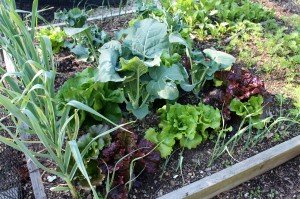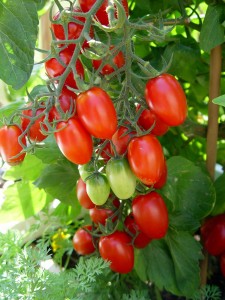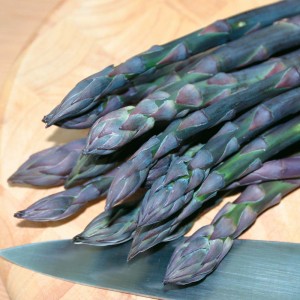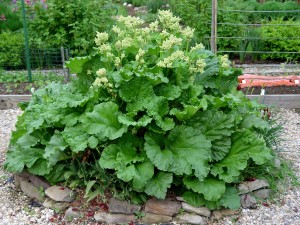Veggies with the Best Payback
April 8th, 2014
The soil finally warmed and dried enough that I could sneak the first crops into my 2014 vegetable garden – about 2 weeks later than usual.
We’ve got some catching up to do this year.
One thing I’ve always tried to do is maximize my edible return for the time, work and space I invest in the veggie garden.
Garden long enough, and you start to realize that some crops work out much better than others.
Onions, beans and peppers, for example, give most gardeners a good return for their effort while fare such as watermelon, eggplant and sweet corn are apt to disappoint as often as pay off (at least they have for me).
If you ran a cost/benefit analysis on home-garden crops, which would gravitate to the top?
Which give reliably good yields of the most valuable and nutritious crops without taking up a ton of space or breaking the budget on sprays, water and fertilizer?
Here’s my top 10 list of veggies that offer the best payback:
1.) Tomatoes
Yeah, they’re prone to septoria leaf spot, blight and a few other challenges, but the payoff is huge. The taste and nutritional value of a home-grown tomato picked at peak ripeness is light years ahead of supermarket fare.
The cost of store-bought tomatoes coupled with the likely yield makes this gardening’s best investment. Tomato plants are easy to start from seed, and the fruits are superb for both canning and freezing.
2.) Peppers
Both hot and sweet bell peppers are easy to grow and have few in-the-garden problems.
Yields are good, store prices make the effort worth it, and peppers are versatile in the kitchen.
The biggest drawback: it takes weeks longer with more risk of loss if you’re shooting for maximum-nutrition, fully ripe red/orange/yellow fruits.
3.) Cucumbers
Overcome the main problem of wilt-spreading cucumber beetles, and you’ll swim in fresh cucumbers for months. Turn cukes into pickles and the value goes even higher.
Cucumbers are cheap and easy to start from seed planted directly in the garden.
Avoid pesticides, and spread out the harvest by planting new seeds every few weeks throughout summer. As wilt takes down older plants, young ones take over.
4.) Asparagus
One of the few perennial veggies, asparagus is planted by roots and can produce weeks’ worth of nutritious shoots each year for decades.
Because it’s a once-and-done planting, the long-term investment is high — especially given the cost of store-bought asparagus. Give asparagus its own patch so shoots don’t migrate into other crops.
Weeds are the main challenge, although plants occasionally are attacked by a beetle. Otherwise, asparagus is drought-tough, low-care and even good-looking when the ferny foliage opens post-harvest.
5.) Onions/Leeks/Shallots/Garlic
Hardly anything bothers the onion family. Just keep these watered, and they’re all among the cheapest, easiest-to-grow crops.
Onions aren’t that expensive but at least are good keepers and versatile. Despite their ease of growth, leeks, shallots and garlic fetch a good price at the store, making them winners in any cost/benefit analysis.
6.) Lettuce
Leaf types are easiest to grow and keep churning out fresh spring salads until heat turns them bitter. But new crops can be planted for fall and even winter in milder climates or with protection.
All lettuce is cheap to grow from direct-planted seed. The main adventure is keeping the bunnies from beating you to harvest.
7.) Squash
Excess-harvest jokes about zucchini are legendary, but almost all summer squashes are tireless producers — that is, until either mildew or squash vine borers take them down. But by then, even a short-circuited production will have paid you back royally for the minor cost of seed.
Both squash problems are stoppable, or use the same trick as with cucumbers… seed several times so you’ll have a backup supply in the wings.
8.) Rhubarb
Like asparagus, rhubarb is a perennial vegetable. You’ll get years of strawberry/rhubarb pies and strawberry/rhubarb jelly from the stalks your expanding plants will put out each season.
Other than rotting out in wet clay (a no-no for any vegetable garden anyway), rhubarb is low-care and long-lasting. And it’s a bold, beautiful plant with its large leaves and reddish stalks.
9.) Beans
Bush beans are another inexpensive, seed-grown crop that usually yields several pickings before the pods peter out. Because they’re among the quickest from seed to harvest, beans can go in several times from spring through summer.
Other than groundhog and rabbit attacks and occasional forays with a beetle, these are pretty reliable.
10.) Snow peas
Timing is everything here. Get your pea seeds in as soon as the ground thaws in spring, and you’ll enjoy weeks of pod-picking before heat shuts down production.
Little goes wrong with snow peas, and you can eat the whole pod with no wasted time shelling.
Some veggie varieties that are more challenging — and why:
Broccoli: Cabbageworm magnets. Quick to flower when the weather warms.
Carrot: Demands deep, loose soil. Rust flies and rabbits are talented enemies.
Eggplant: Picky about soil. Flea-beetle magnets.
Melon: Needs lots of water, long growing season and skill for judging when they’re ready.
Parsnip: Often turn woody, especially in hot, dry weather. Long grow time.
Spinach: Gets bitter and bolts to seed in heat. Leaf-miners love it.
Sweet corn: Water and space hogs, prone to corn earworms.
Sweet potato: Long growing season, needs lots of warmth and vulnerable to voles.











